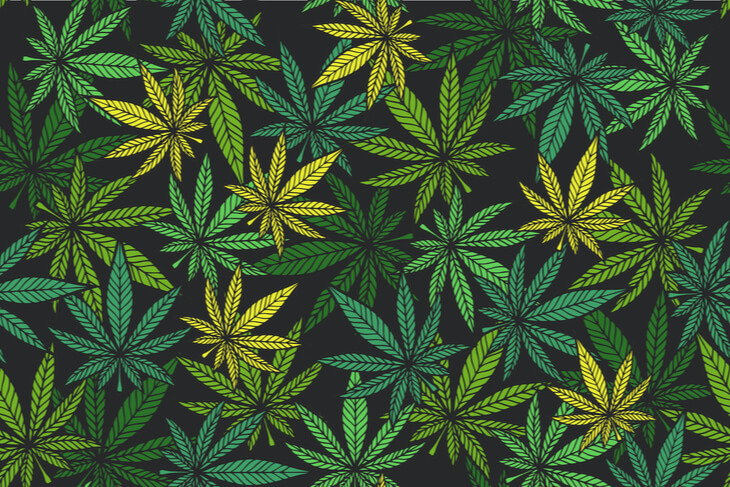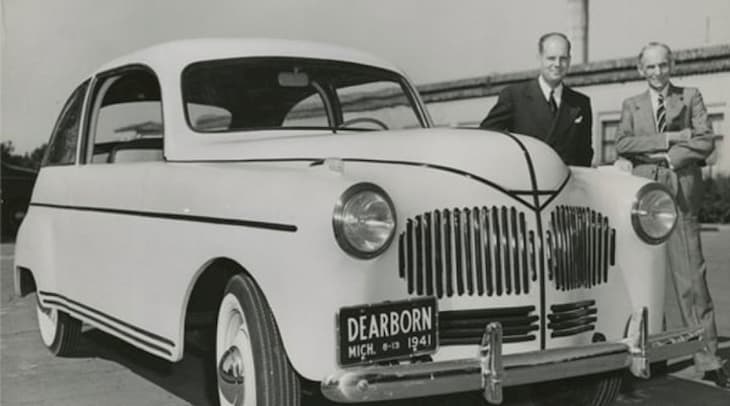
Are all the strains beginning to strain your brain? What does all of the jargon like “Indica-dominant, uplifting and creative, with a mellow body high” really mean? Let’s explore the different aspects of marijuana breeding and find out the simple facts behind cannabis strains. This crash course on Mary Jane strains will infuse you with the knowledge to find out the difference between a Bubble Gum Kush from an O.G. Skywalker and even describe why and how they’re different. You might wonder, “What’s with all of these made-up words? I thought pot was pot!”, or you may have heard crazy stuff like Henry Ford made a car out of pot, and even ran it off of pot biodiesel.

The author can’t believe Snoop Dogg hasn’t replicated this experiment. Where you at, Snoop? Spoiler alert: It turns out that Ford really did do that, more about that later. If pot can basically do anything, then clearly, the different varieties need names. This is how we ended up with a bajillion strains today. Here’s what you need to know to chart your way through the cannabis jungle.
First, let’s break down what a cannabis strain really is. When people speak of strains, they are referring to distinct hybrids of a particular lineage. When a new variety is created, and it is especially good for a specific thing or otherwise achieves renown, it is often given a name such as “Diesel.” Modern plants are all derived originally from a handful of prototypical varieties of cannabis, which grew wild and had natural mutations. Through generations of cultivation and isolation, these once very similar plants have diverged dramatically in their characteristics. When contemporary cultivators want to create a new cannabis hybrid, they design their vision for the new plant by creating a list of desired effects. They then look for plants that exhibit these effects, which might be bred together to form offspring with a mix of the parent plants’ characteristics. The offspring may express genes from either parent plant, activate dormant genes, or produce combinations of chemicals that change the effects their parents were known for. We have a ways to go before we can type in what we want and get DNA for a plant with those exact attributes produced by a genetic editing machine. We’ve gotten pretty far with traditional farming, however, and there exists a dazzling variety of strains out there. Through many generations of breeding, the plants we know today are a far cry from the most popular pot of the past. Just like corn, rice, or cotton, hemp plants have been bred for different purposes throughout the ages. Commercial farmers, hobbyists, and aficionados apply a blend of science and artistry to build upon the successes of their predecessors. Until we develop a standardized method of discussing marijuana, people will continue to use terms that are ambiguous or even misleading. Instead, let’s focus on where these descriptions come from and how cannabis can do all of the miraculous things people claim.
A history of versatility
Did you know you can make a pot… out of pot? While wearing pot? And eating pot? Perhaps driving this pot made of pot around in your car made out of pot and fueled by pot? Be sure to keep the sun out of your eyes with your sunglasses made from pot for good measure. Oh yes, read on, it’s a trip.
“Well that certainly illustrates the diversity of the word”
– Boondock Saints
Pot isn’t just smoked or made into tea. In fact, some kinds aren’t very good for those uses, but due to changing human needs, many cannabis strains have been bred to be. As a result, there is no ‘Best Weed on Earth’ champion, there are simply better plants for specific needs. Even before the contemporary surge in marijuana popularity, Some researchers believe that cannabis began its symbiotic relationship with humans around 500 BCE in Asia. In Siberia and China, burned pot seeds were found in shaman burial sites. Marijuana spent most of its history being used as a medicine, not an intoxicant. It was grown in the famous Spanish Missions of the Southwestern U.S., and three states even mandated that their farmers produce hemp.
Today, people still use the hemp plant to produce medicines, some of the world’s strongest rope, clothing, plastics, foods, and even fuel. Henry Ford, being a farmer himself, researched bioplastics and biofuels as a solution to shortages caused by World War II. He went as far as to create a car from hemp bioplastic and run it on hemp biofuel many decades before this would become popular. From clothing and pharmaceuticals to automobiles and just plain getting high, hemp has an established history as one of our most loved plants. Early adherents of Islam utilized it by smoking, as alcohol and other intoxicants were prohibited, but cannabis was not. Early America was introduced to the concept of recreational use during the Mexican Revolution and have been consuming Mexican grown marijuana ever since.
There are certainly some very intoxicating cannabis strains available now. Still, no evidence has been credibly presented that speaks to the carcinogenicity or toxicity of marijuana in humans. In today’s recreational and medicinal marijuana strains, according to the US FDA, there is typically between 3 and 10 times as much THC content as there was just a couple of decades ago. THC is, however, only one out of nearly 500 known chemicals and compounds produced by cannabis. Of these, over 113 are cannabinoids themselves. Therefore THC tracking is not a useful measure of anything except tetrahydrocannabinol content. CBD, or cannabidiol, is another essential active compound for medicinal use. Counterintuitively, CBD blocks the effect of THC in the nervous system. As you can probably imagine from this example, the combinations of cannabinoids can assume nearly infinite combinations with an equal variety of effects.
While you cannot “overdose” on weed as far as is currently understood, you may find that certain marijuana strains have effects which you do not like. Some strains may exacerbate the symptoms of existing conditions you wish to treat. For these reasons, information about the origin and breeding of the plant is critical to making an informed decision. One day physicians may have to study these details in school to make informed decisions regarding the prescription of cannabinoids for medical treatment. Physicians and the greater scientific community are busy studying the chemicals produced by cannabis in laboratories and universities around the world by consuming it in their spare time. They are also doing real science to uncover the facts for us when resources are available. It probably isn’t tough to find candidates to study this plant, but funding can be a problem. Hopefully, we will soon have the information needed to draw a functional map for consumers, patients, and prescribers.
What is well understood is that from strain to strain, and even one plant to another, the effects can be astoundingly different. If you live in a jurisdiction that doesn’t criminalize the cultivation of this plant, you may be able to find a cannabis strain that suits your needs by consulting a grower or an expert in your local dispensary, pharmacy, or store. The corpus of cannabis research is still small, and there is much work to be done. New information is published very frequently, and nobody knows everything yet. Variable factors such as plant lineage, growing conditions, the nature of the universe, and the skill of the producer may also affect the plant, so it’s probably best if you understand the differences yourself for now.
Indica vs Sativa vs Ruderalis?
It is inaccurate to describe any species as having a particular type of effect, or high. Some species are known to generally exhibit a tendency toward more THC, for example. Still, exact causal relationships for particular plants producing a specific chemical are, as I have previously outlined, under investigation. Significant differences between species do exist that are important in terms of growing cannabis.
Sativa
Sativa is the feminized form of the Latin botanical adjective ‘sativum’, which simply means ‘cultivated.’ Sativa was named by a Swedish physician, zoologist, and botanist Carl Linnaeus (A.K.A. Carolus a Linné, Carl Von Linné, Carolus Linnæus). Linnaeus is known as the father of modern taxonomy. This species is known for shorter growing periods, and a short, bushy appearance. The leaves in each cluster are more broad and stubby. They are more suitable for growing in colder climates at more extreme latitudes because they have a shorter life cycle that can accommodate a shorter season. In contrast to everything else being shorter, the flowers produced are arranged in a long tapered cluster of buds. The high from Sativa tends to be more ‘cerebral,’ meaning noticeable in terms of altered thinking, mood, and some say spiritual effect with less nerve sensation or altered perception of physical forces.
Indica
Indica, another cultivated species, is so named because it developed in isolation on the Indian subcontinent. Characteristics include longer and narrower leaves, taller tree-like plants, and longer life cycles that require longer seasons. Indica bud clusters tend to be squatter and larger in diameter. Not too long after Sativa was described by Linnaeus, another smart guy with a confusing name came along and described the Indica species. Jean-Baptiste Pierre Antoine de Monet, chevalier de Lamarck (just call him Lamarck). Lamarck’s observations in the biological sciences led to the first real theory we ever had for biological evolution and inheritance. Clearly, complicated cannabis would have been interesting to this guy. Anecdotal reports suggest that Indica highs are generally more palpable than those from Sativa strains, described as a “body high”, in contrast to Sativa’s “head high.”
Ruderalis
Ruderalis, derived from the Latin word rudera, which is the plural form of rudus, which basically means a lump or chunk of something. It is kind of chunky looking. This lesser-known variety of cannabis which actually looks like a weed more than its cousins rarely grows 0.75 meters tall and has big, broad leaves. This traveler can be found in the midwestern United States, Siberia, the Northern Himalayas, and across central Europe. First described by another genius (known by a shorter name – phew), Russian botanist D. E. Janischewsky, this variety can do some neat tricks. Whereas other species have a flowering cycle controlled by diurnal light cycles, this plant is done when it’s done. There’s no time to waste when you’re a jet-setting Ruderalis. They will flower when they’re ready – at full maturity, a characteristic which has come to be called “auto-flowering”. Lower THC content and higher CBD content make this species a good pick for CBD oil extraction, and persons treating the broad range of symptoms for which CBD is believed to be effective. The auto-flowering capability can be preserved when Ruderalis is mixed with Indica or Sativa species. More compact, hardy plants that don’t require special light control techniques are beneficial to home growers, amateurs, and people who would like multiple harvests per growing season. Weed lumps that help us in the fight against cancer and other awful things, what’s not to love?
What’s in the name of cannabis strain?
New subspecies of marijuana are continuously developed, and since they can all be so vastly different, a naming convention has emerged. If you had a cannabis strain called “Papa Smurf” which you bred with “Dreamsicle”, you might name the result “Papa Dream” or “Smurfsicle” so that people could recognize its lineage by identifying the more well-known strains. A particular region or famous grower might be associated with a strain, like “Chris Smith’s Smurfsickle” to denote that it is of that grower’s lineage, which might be a cross between a different kind of Papa Smurf and Dreamsicle and might not have exactly the same cannabinoid profile as Chris’ plants. Naming similar to that of remixed music also appears sometimes. If the parent strains are known, and the character of those plants is familiar to you, you can somewhat estimate the outcome of hybridizing them. If a grower continually refines the hybrid for a specific trait, it might be named for what it is popularly used for. When plant populations are separated long enough, they evolve different adaptations. Just because someone says “This is Northern Lights” doesn’t mean it necessarily has the same character as Northern Lights grown 5,000 km away or many years ago. Therefore names can serve as a useful guide when they are accurate, but if you travel or buy from another source, expect to have to judge for yourself.
Now you know the difference between species and cannabis ‘strains’ and the truth about the Indo vs Sativa debate. You should be able to identify generally which species’ traits likely to be most prevalent in the cannabis you encounter based on its physical characteristics. Lineage has been explained, and the goofy names hopefully make a lot more sense.


